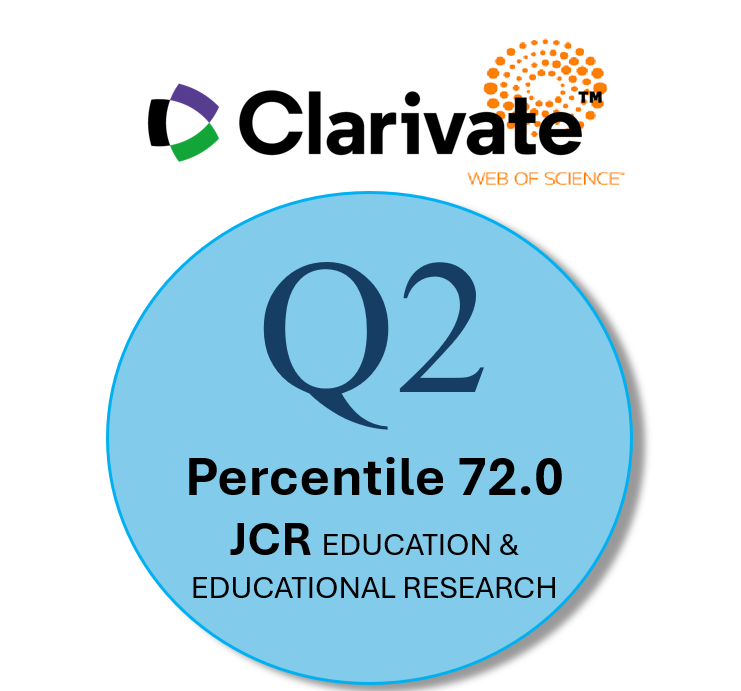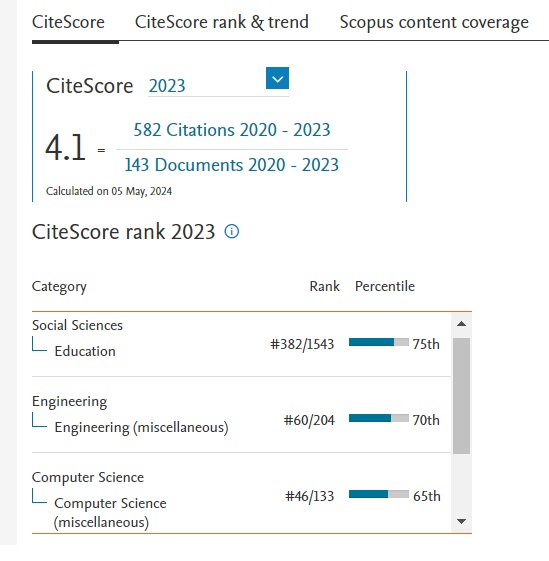Modelización 3D de última generación y simulación mediante dispositivos de realidad virtual para mejorar el proceso de enseñanza-aprendizaje de cirugía hepatobiliar con alumnos de medicina
Resumen
Los nuevos dispositivos de modelización 3D de última generación y simulación con gafas de realidad virtual suponen una nueva herramienta que puede ser utilizada con para mejorar la compresión de la cirugía hepatobiliar en los estudiantes de medicina. Entre septiembre de 2022 y enero de 2024 realizamos un estudio prospectivo entre los alumnos de medicina de 4º curso. Se implementó una nueva metodología docente basada en innovaciones tecnológicas centradas en 3D de última generación. Mediante una encuesta se valoraron índices de satisfacción, utilidad, mejora, implementación, compresión y motivación. Un total de 46 alumnos contestaron al cuestionario. Un 95,7% estaban de acuerdo con que los modelos virtuales 3D y la realidad virtual favorecen a mostrar un mayor interés por la clase sin ninguna respuesta desfavorable al respecto. Un 95,7% coinciden con que la utilización de modelos impresos en 3D deberían tener más presencia en las clases de cirugía. Un 97,8% estaban de acuerdo en que los vídeos quirúrgicos asistidos por reconstrucciones 3D deberían tener más presencia en las aulas. Los resultados de este estudio respaldan la efectividad y la aceptación de la metodología docente basada en tecnología 3D en la enseñanza de la anatomía quirúrgica hepática.
Descargas
-
Resumen647
-
PDF489
Citas
Al‐Badri, N., Touzet‐Roumazeille, S., Nuytten, A., Ferri, J., Charkaluk, M. L., & Nicot, R. (2022). Three‐dimensional printing models improve long‐term retention in medical education of pathoanatomy: A randomized controlled study. Clinical Anatomy, 35(5), 609-615.
Ammanuel, S., Brown, I., Uribe, J., & Rehani, B. (2019). Creating 3D models from radiologic images for virtual reality medical education modules. Journal of medical systems, 43(6), 166.
Aranda, F. P., Piñeiro, L. V., Pérez, M. C., & Andorrà, E. C. (2022). Robotic cholecystectomy and transcystic common bile duct exploration with augmented reality glasses and indocyanine green in a patient with a cystic duct cyst. Cirugia Espanola, 101(8), 562-563.
Azer, S. A., & Azer, S. (2016). 3D anatomy models and impact on learning: a review of the quality of the literature. Health professions education, 2(2), 80-98.
Berney, S., Bétrancourt, M., Molinari, G., & Hoyek, N. (2015). How spatial abilities and dynamic visualizations interplay when learning functional anatomy with 3D anatomical models. Anatomical sciences education, 8(5), 452-462.
Chen, G., Li, X. C., Wu, G. Q., Zhang, S. X., Xiong, X. F., Tan, L. W., ... & Dong, J. H. (2010). Three-dimensional reconstruction of digitized human liver: based on Chinese Visible Human. Chinese medical journal, 123(02), 146-150.
Chedid, V. G., Kamath, A. A., Knudsen, J. M., Frimannsdottir, K., Yost, K. J., Geske, J. R., ... & Kamath, P. S. (2020). Three-dimensional-printed liver model helps learners identify hepatic subsegments: A randomized-controlled cross-over trial. Official journal of the American College of Gastroenterology| ACG, 115(11), 1906-1910.
Cheng, J., Wang, Z. F., Yao, W. F., Liu, J. W., Lu, Y., Wang, Q., & Cai, X. J. (2023). Comparison of 3D printing model to 3D virtual reconstruction and 2D imaging for the clinical education of interns in hepatocellular carcinoma: a randomized controlled study. Journal of Gastrointestinal Oncology, 14(1), 325-333.
Del Cerro Velázquez, F., & Morales Méndez, G. (2021). Systematic review of the development of spatial intelligence through augmented reality in stem knowledge areas. Mathematics, 9(23), 3067.
DeOliveira, M. L., Schulick, R. D., Nimura, Y., Rosen, C., Gores, G., Neuhaus, P., & Clavien, P. A. (2011). New staging system and a registry for perihilar cholangiocarcinoma. Hepatology, 53(4), 1363-1371.
Giehl-Brown, E., Dennler, S., Garcia, S. A., Seppelt, D., Oehme, F., Schweipert, J., ... & Riediger, C. (2023). 3D liver model-based surgical education improves preoperative decision-making and patient satisfaction—A randomized pilot trial. Surgical Endoscopy, 37(6), 4545-4554.
Glossop, S. C., Bhachoo, H., Murray, T. M., Cherif, R. A., Helo, J. Y., Morgan, E., & Poacher, A. T. (2023). Undergraduate teaching of surgical skills in the UK: systematic review. BJS open, 7(5).
Huang, Z., Song, W., Zhang, Y., Zhang, Q., Zhou, D., Zhou, X., & He, Y. (2018). Three-dimensional printing model improves morphological understanding in acetabular fracture learning: A multicenter, randomized, controlled study. PloS one, 13(1).
Jurgaitis, J., Paškonis, M., Pivoriūnas, J., Martinaitytė, I., Juška, A., Jurgaitienė, R., ... & Strupas, K. (2008). The comparison of 2-dimensional with 3-dimensional hepatic visualization in the clinical hepatic anatomy education. Medicina, 44(6), 428-438.
Keller, J. (2010). Motivational design for learning and performance. Science þ Business Media, 227–286, Springer.
Kong, X., Nie, L., Zhang, H., Wang, Z., Ye, Q., Tang, L., ... & Li, J. (2016). Do 3D printing models improve anatomical teaching about hepatic segments to medical students? A randomized controlled study. World journal of surgery, 40, 1969-1976.
Langlois, J., Wells, G. A., Lecourtois, M., Bergeron, G., Yetisir, E., & Martin, M. (2015). Spatial abilities of medical graduates and choice of residency programs. Anatomical Sciences Education, 8(2), 111-119.
Li, Z., Li, Z., Xu, R., Li, M., Li, J., Liu, Y., ... & Chen, Z. (2015). Three-dimensional printing models improve understanding of spinal fracture—A randomized controlled study in China. Scientific reports, 5(1), 11570.
Lim, K. H. A., Loo, Z. Y., Goldie, S. J., Adams, J. W., & McMenamin, P. G. (2016). Use of 3D printed models in medical education: A randomized control trial comparing 3D prints versus cadaveric materials for learning external cardiac anatomy. Anatomical sciences education, 9(3), 213-221.
Lopez-Lopez, V., Robles-Campos, R., García-Calderon, D., Lang, H., Cugat, E., Jiménez-Galanes, S., ... & Parrilla-Paricio, P. (2021a). Applicability of 3D-printed models in hepatobiliary surgey: results from “LIV3DPRINT” multicenter study. HPB, 23(5), 675-684.
Lopez-Lopez, V., Gomez-Perez, B., de Vicente, E., Jiménez-Galanes, S., Mora-Oliver, I., Sabater, L., ... & Robles-Campos, R. (2021b). Next-generation three-dimensional modelling software for personalized surgery decision-making in perihilar cholangiocarcinoma: multicentre study. British Journal of Surgery, 108(12), 394-395.
Lopez-Lopez, V., Sánchez-Esquer, I., Crespo, M. J., Navarro, M. Á., Brusadin, R., Conesa, A. L., ... & Robles-Campos, R. (2023). Development and validation of advanced three-dimensional navigation device integrated in da Vinci Xi® surgical robot for hepatobiliary surgery: pilot study. British Journal of Surgery, 110(1), 108-110.
Mayer, R. E., & Moreno, R. (2003). Nine ways to reduce cognitive load in multimedia learning. Educational psychologist, 38(1), 43-52.
Metzler, R., Stein, D., Tetzlaff, R., Bruckner, T., Meinzer, H. P., Büchler, M. W., ... & Fischer, L. (2012). Teaching on three-dimensional presentation does not improve the understanding of according CT images: a randomized controlled study. Teaching and learning in medicine, 24(2), 140-148.
Samadbeik, M., Yaaghobi, D., Bastani, P., Abhari, S., Rezaee, R., & Garavand, A. (2018). The applications of virtual reality technology in medical groups teaching. Journal of advances in medical education & professionalism, 6(3), 123.
Sattar, M., Palaniappan, S., Lokman, A., Shah, N., Khalid, U., & Hasan, R. (2020). Motivating medical students using virtual reality based education. International Journal of Emerging Technologies in Learning (iJET), 15(2), 160-174.
Stull, A. T., Hegarty, M., & Mayer, R. E. (2009). Getting a handle on learning anatomy with interactive three-dimensional graphics. Journal of educational psychology, 101(4), 803.
Pottle, J. (2019). Virtual reality and the transformation of medical education. Future healthcare journal, 6(3), 181.
Wang, Z., Liu, Y., Luo, H., Gao, C., Zhang, J., & Dai, Y. (2017). Is a three-dimensional printing model better than a traditional cardiac model for medical education? A pilot randomized controlled study. Acta Cardiologica Sinica, 33(6), 664-669.
Wu, A. M., Wang, K., Wang, J. S., Chen, C. H., Yang, X. D., Ni, W. F., & Hu, Y. Z. (2018). The addition of 3D printed models to enhance the teaching and learning of bone spatial anatomy and fractures for undergraduate students: a randomized controlled study. Annals of translational medicine, 6(20).
Yi, X., Ding, C., Xu, H., Huang, T., Kang, D., & Wang, D. (2019). Three-dimensional printed models in anatomy education of the ventricular system: a randomized controlled study. World neurosurgery, 125, 891-901.
Zhang, H., He, Y., Chen, Y., Liu, J., Jin, Q., Xu, S., ... & Niu, F. (2021). Virtual reality and three-dimensional printed models improve the morphological understanding in learning mandibular sagittal split ramus osteotomy: a randomized controlled study. Frontiers in Surgery, 8, 705532.
Derechos de autor 2024 Revista de Educación a Distancia (RED)

Esta obra está bajo una licencia internacional Creative Commons Atribución-NoComercial 4.0.
Las obras que se publican en esta revista están sujetas a los siguientes términos:
1. El Servicio de Publicaciones de la Universidad de Murcia (la editorial) conserva los derechos patrimoniales (copyright) de las obras publicadas, y favorece y permite la reutilización de las mismas bajo la licencia de uso indicada en el punto 2.
2. Las obras se publican en la edición electrónica de la revista bajo una licencia Creative Commons Reconocimiento-NoComercial-SinObraDerivada 3.0 España (texto legal). Se pueden copiar, usar, difundir, transmitir y exponer públicamente, siempre que: i) se cite la autoría y la fuente original de su publicación (revista, editorial y URL de la obra); ii) no se usen para fines comerciales; iii) se mencione la existencia y especificaciones de esta licencia de uso.
3. Condiciones de auto-archivo. Se permite y se anima a los autores a difundir electrónicamente las versiones pre-print (versión antes de ser evaluada) y/o post-print (versión evaluada y aceptada para su publicación) de sus obras antes de su publicación, ya que favorece su circulación y difusión más temprana y con ello un posible aumento en su citación y alcance entre la comunidad académica. Color RoMEO: verde.














